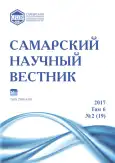Comparison of cobalt compounds content in organs and tissues of woody plants
- Authors: Sibirkina A.R.1, Likhachev S.F.1
-
Affiliations:
- Chelyabinsk State University
- Issue: Vol 6, No 2 (2017)
- Pages: 84-87
- Section: 03.02.00 – General Biology
- URL: https://journals.rcsi.science/2309-4370/article/view/21802
- DOI: https://doi.org/10.17816/snv201762116
- ID: 21802
Cite item
Full Text
Abstract
The paper presents results of a comparative analysis of cobalt compounds content in the organs and tissues of woody plants in pine forests of the Semipalatinsk Irtysh Republic of Kazakhstan. The investigated forests belong to the dry-steppe area of the Irtysh ribbon belt on the sands of the Irtysh and the provinces of the Priirtyshsky belt in the valleys of the ancient runoff. The investigated area of borons is characterized by a simple stand, formed by trees of approximately one height (20-25 m). The fluctuations between the heights of individual trees do not exceed 10-15%. Scots pine (Pinus sylvestris L.) is a species - edificator. Aspen (Populus tremula L.) and birch pendant (Betula pendula Roth.) are trees of the second size. They appeared after fires and intensive deforestation as a result of secondary succession. Particular attention was paid to needles during the analysis. Needles perform an assimilating function and determine the growth and development of other organs. The determination of cobalt compounds was carried out at the Institute of Geology and Mineralogy (IGM SB RAS) (Novosibirsk) using atomic absorption spectroscopy methods. The calculation of the biogeochemical cycle of the stand was carried out. The mass of cobalt compounds involved in the biogeochemical cycle with the total phytomass of the stand was 0,0090 t / ha, and the phytomass of the aboveground part of the tree was 0,0087 t / ha. The state of the stand according to the Kraft classification corresponds to the I-III class of vitality, depending on the site of occurrence. The stand of boron is characterized by high capacity of biological absorption of cobalt compounds. A comparative analysis of the accumulation of cobalt compounds by different types of trees was carried out. Leaves and branches of deciduous trees are characterized by the maximum accumulation of cobalt compounds in comparison with pine needles and Pinus sylvestris L. The leaves of Populus tremula L. accumulate more cobalt compounds than leaves of Betula pendula Roth. According to the series of biological absorption, cobalt is an element of strong accumulation for woody plants, based on the potential biogeochemical mobility of metals. Cobalt does not play an important role in the general circulation of substances in the forest ecosystem, based on the biotic index.
Keywords
Full Text
##article.viewOnOriginalSite##About the authors
Alfira Raviljevna Sibirkina
Chelyabinsk State University
Author for correspondence.
Email: sibirkina_alfira@mail.ru
doctor of biological sciences, associate professor, head of Geoecology and Nature Management Department
Russian FederationSergej Fedorovich Likhachev
Chelyabinsk State University
Email: likhaschev@mail.ru
doctor of biological sciences, professor, head of Ecology Faculty
Russian FederationReferences
- Лазарев А.И. Дары щедрого леса. Алма-Ата: Кайнар, 1990. 304 с.
- Грибанов Л.Н. Степные боры Алтайского края и Казахстана. М.-Л., 1960. С. 67-69.
- Пашковский К.А. Возобновление сосны в ленточных борах Прииртышья. Алма-Ата: Наука, 1951. С. 22-28.
- Родин Л.Е., Базилевич Н.И. Динамика органического вещества и биологический круговорот зольных элементов и азота в основных типах растительности земного шара. М.-Л.: Наука, 1965. 254 с.
- Глазовский Н.Ф. Биогеохимический круговорот химических элементов и подходы к его изучению // Биогеохимический круговорот веществ в биосфере. М.: Наука, 1987. С. 56-64.
- Дунаев Е.А. Деревянистые растения Подмосковья в осеннее-зимний период: методы экологических исследований. М.: МосгорСЮН, 1999. 232 с.
- Власова Н.П. Практикум по лесным травам. М.: Изд-во Агропромиздат, 1986. 108 с.
- Тюрин А.В., Науменко Н.М., Воропанов П.В. Лесная вспомогательная книжка. М.-Л., 1956. 532 с.
- Денисов С.И. Полевая практика по экологии: учебное пособие. Мн.: Университет, 1999. 120 с.
- Пахарькова Н.В., Калякина О.П., Шубин А.А., Григорьев Ю.С., Пахарьков С.В., Сорокин Г.А. Различия в акклимационных стратегиях сосны обыкновенной и ели сибирской на загрязнение воздушной среды // Хвойные бореальной зоны. 2010. № 3. С. 231-236.
- Уваров Г.И., Голеусов П.В. Практикум по почвоведению с основами бонитировки почв. Белгород: Изд-во Белгор. гос. ун-та, 2004. 140 с.
- Сибиркина А.Р. Биогеохимическая оценка содержания тяжелых металлов в сосновых борах Семипалатинского Прииртышья: автореф. дис. … д-ра биол. наук: 03.02.08. Омск: ОмГПУ, 2014. 38 с.
- Лукина Н.В., Никонов В.В. Поглощение аэротехногенных загрязнителей растениями сосняков на северо-западе Кольского полуострова // Лесоведение. 1993. № 6. С. 34-41.
Supplementary files







